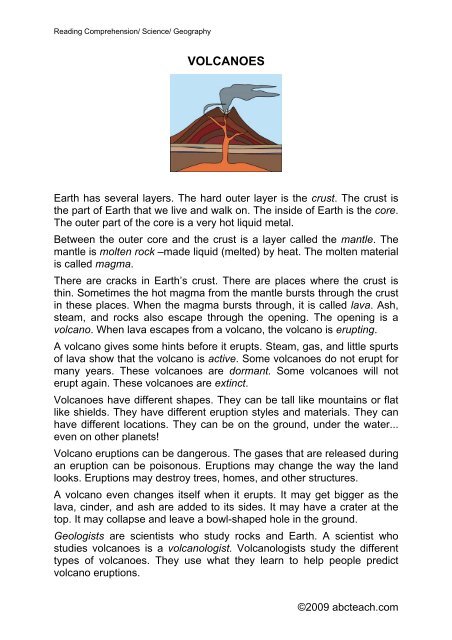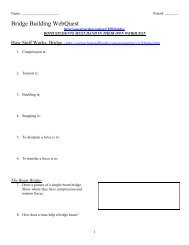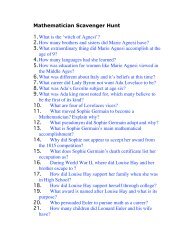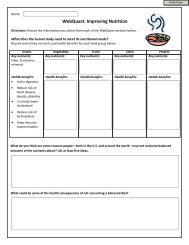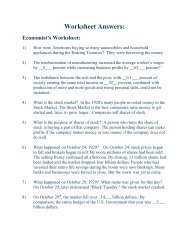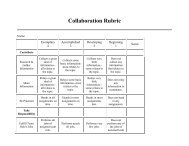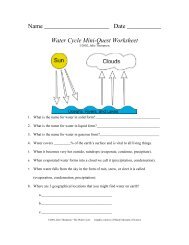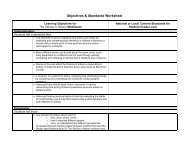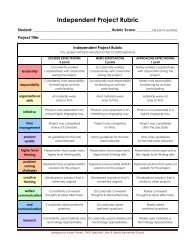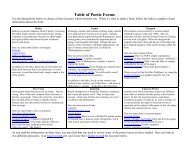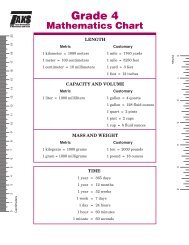Create successful ePaper yourself
Turn your PDF publications into a flip-book with our unique Google optimized e-Paper software.
Reading Comprehension/ Science/ Geography<strong>VOLCANOES</strong>Earth has several layers. The hard outer layer is the crust. The crust isthe part of Earth that we live and walk on. The inside of Earth is the core.The outer part of the core is a very hot liquid metal.Between the outer core and the crust is a layer called the mantle. Themantle is molten rock –made liquid (melted) by heat. The molten materialis called magma.There are cracks in Earth’s crust. There are places where the crust isthin. Sometimes the hot magma from the mantle bursts through the crustin these places. When the magma bursts through, it is called lava. Ash,steam, and rocks also escape through the opening. The opening is avolcano. When lava escapes from a volcano, the volcano is erupting.A volcano gives some hints before it erupts. Steam, gas, and little spurtsof lava show that the volcano is active. Some volcanoes do not erupt formany years. These volcanoes are dormant. Some volcanoes will noterupt again. These volcanoes are extinct.Volcanoes have different shapes. They can be tall like mountains or flatlike shields. They have different eruption styles and materials. They canhave different locations. They can be on the ground, under the water...even on other planets!Volcano eruptions can be dangerous. The gases that are released duringan eruption can be poisonous. Eruptions may change the way the landlooks. Eruptions may destroy trees, homes, and other structures.A volcano even changes itself when it erupts. It may get bigger as thelava, cinder, and ash are added to its sides. It may have a crater at thetop. It may collapse and leave a bowl-shaped hole in the ground.Geologists are scientists who study rocks and Earth. A scientist whostudies volcanoes is a volcanologist. Volcanologists study the differenttypes of volcanoes. They use what they learn to help people predictvolcano eruptions.©2009 abcteach.<strong>com</strong>
Reading Comprehension/ Science/ GeographyName _____________________ Date ________________ANSWER THE QUESTIONS ABOUT <strong>VOLCANOES</strong>:1. The layers of Earth, in order from outer to inner, are:a. crust, core, mantleb. crust, inner core, mantle, outer corec. crust, mantle, outer core, inner cored. crust, outer core, mantle, inner core2. Which of the following things could be described as molten?a. pudding, before it has hardenedb. ice cream, after it has meltedc. magmad. all of the above3. Volcanoes erupt in places…a. Where Earth’s crust is thinb. Where Earth’s crust is crackedc. Where they are unexpectedd. Both a and b4. When hot liquid <strong>com</strong>es out of a volcano, this isa. an eruptionb. an explosionc. dormantd. on another planet5. A volcano eruption isa. dangerous for plants and animalsb. dangerous only for animalsc. dangerous only for peopled. dangerous only for plants6. Volcano eruptions are dangerous because ofa. the lava, which is bad for plants.b. heat and gas.c. bad smell and smoke.d. nothing. They are not dangerous.7. Where can you find volcanoes?a. on the landb. in the seac. on other planetsd. all of the above©2009 abcteach.<strong>com</strong>
Reading Comprehension/ Science/ GeographyANSWERS TO <strong>VOLCANOES</strong>1. c2. d3. d4. a5. a6. b7. d©2009 abcteach.<strong>com</strong>


